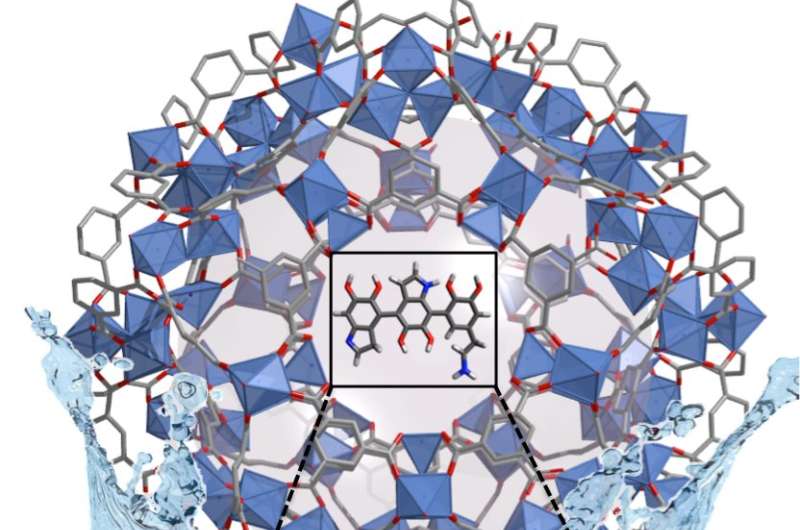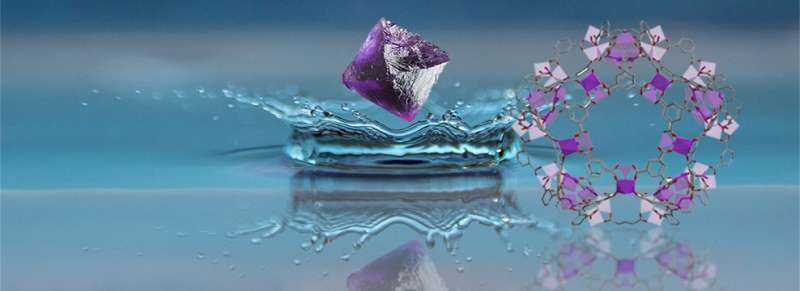Removing heavy metals from water with MOFs

An estimated 1 billion people do not have access to clean drinking water, a problem expected to worsen with climate change, according to the World Health Organization. In addition, higher energy needs and increased use of heavy metals in industrial processes have increased human exposure to these toxic materials from drinking water in recent decades. Researchers now report in ACS Central Science a new material that can remove heavy metals and provide clean drinking water in seconds.
There are many sources of exposure to toxic heavy metals. Lead, in particular, has been used in paints, ceramic glazes, jewelry, toys and in pipes. Current commercial methods to remove heavy metals including lead from municipal drinking water can be expensive in terms of money and energy and are inefficient. In addition, some current approaches either are single-use, are difficult to regenerate or can produce significant toxic waste as a side product. Wendy L. Queen and colleagues sought to attack this issue with materials called metal organic frameworks (MOFs) that are networks of organic chemical 'struts' with metal nodes known to pull things like water and gases from air. That ability, plus the large surface area and chemical tunability of MOFs make them a promising material to remove heavy metals selectively from water.
The researchers created a water-stable MOF/polymer composite with cheap, environmentally and biologically friendly materials and tested its ability to remove heavy metals from water. It had one of the highest reported removal capacities to date, removing over 1.6 times its own weight of mercury and 40 percent of its weight in lead. The researchers tested the MOFs in solutions with lead levels similar to those found in contaminated water samples from Flint, Michigan. They found that the material can rapidly reduce lead concentrations to 2 parts per billion, which is the U.S. Environmental Protection Agency limit for drinkable levels.

Further, the authors removed lead from various real-world water samples from the Rhone River, the Mediterranean Sea and a wastewater treatment plant in Switzerland. The researchers also demonstrated how the material could be regenerated easily without toxic products. The authors say they are now pursuing using other specially designed MOFs to remove other trace contaminants in water.
More information: Rapid, Selective Heavy Metal Removal from Water by a Metal-organic Framework/ Polydopamine Composite, ACS Central Science (2018). pubs.acs.org/doi/10.1021/acscentsci.7b00605
ABSTRACT
Drinking water contamination with heavy metals, particularly lead, is a persistent problem worldwide with grave public health consequences. Existing purification methods cannot often address this problem quickly and economically. Here we report a cheap, water stable metal-organic framework/polymer composite, Fe-BTC/PDA, that exhibits rapid, selective removal of high quantities of heavy metals, such as Pb2+ and Hg2+, from real world water samples. In this work, Fe-BTC, is treated with dopamine, which undergoes spontaneous polymerization to polydopamine (PDA) within its pores via the Fe3+ open metal sites. The PDA, pinned on the internal MOF surface, gains extrinsic porosity resulting in a composite that binds up to 1634 mg Hg2+ and 394 mg Pb2+ per gram of composite and removes over 99.8 % of these ions from a 1 ppm solution, yielding drinkable levels in seconds. Further, the composite properties are well-maintained in river and sea water samples spiked with only trace amounts of lead, illustrating unprecedented selectivity. Remarkably, no significant uptake of competing metal ions is observed even when interferents, such as Na+, are up to 14,000 times the concentration of Pb2+. The material is further shown to be resistant to fouling when tested in high concentrations of common organic interferents, like humic acid, and is fully regenerable over many cycles.
Journal information: ACS Central Science
Provided by American Chemical Society



















